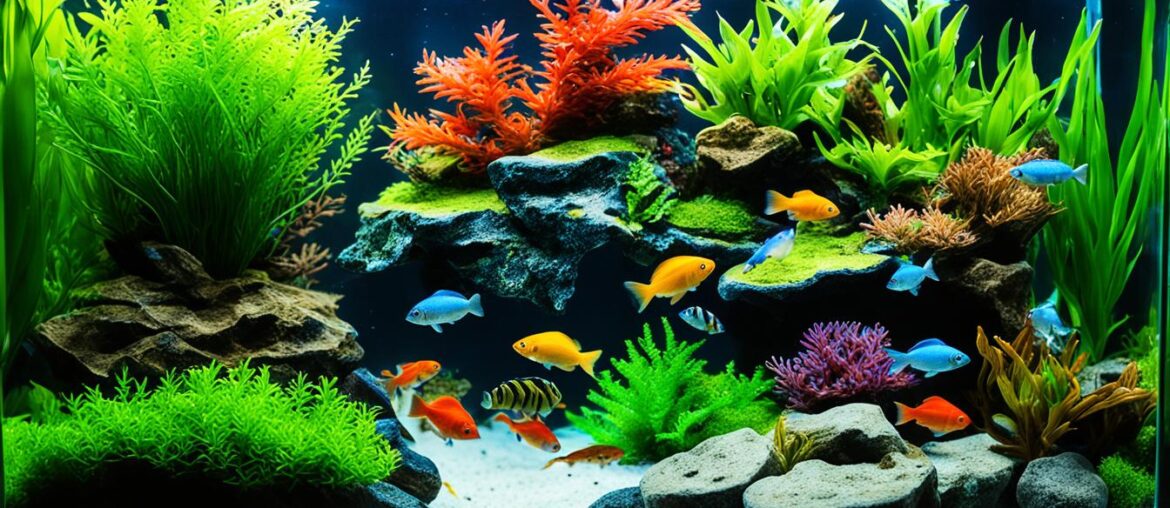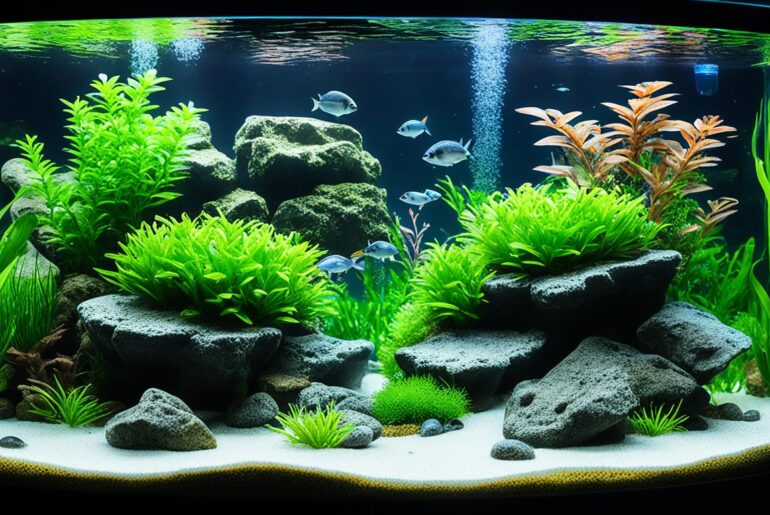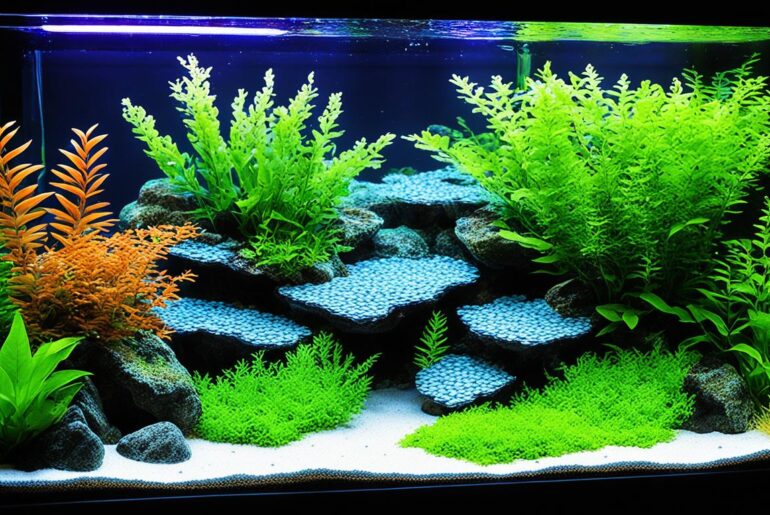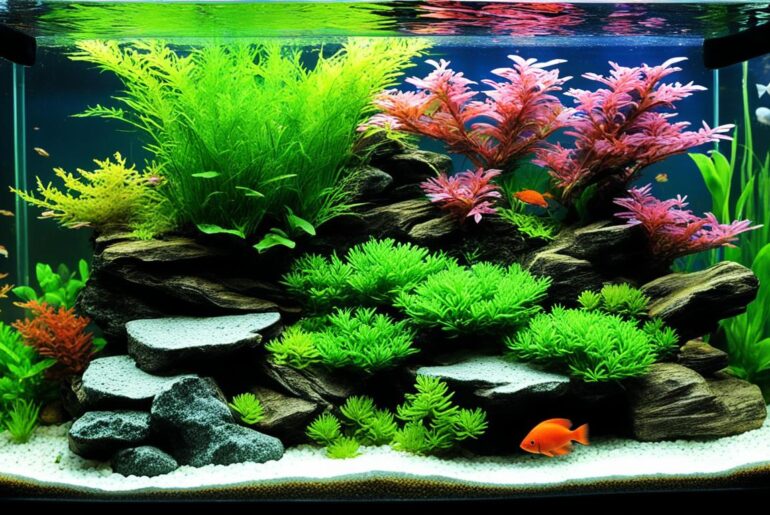As an avid aquarium enthusiast, I have always been captivated by the beauty and tranquility that an underwater world can bring into my home. However, it wasn’t until I faced a devastating incident that I truly understood the importance of temperature control in my freshwater aquarium.
One summer, as the temperatures outside soared, I noticed my fish becoming lethargic and stressed. Alarmed, I quickly realized that the rising heat was taking a toll on their fragile ecosystem. I knew I had to act fast to save them.
Determined to find a solution, I embarked on a journey to perfecting freshwater aquarium temperature control. Countless hours of research, trial, and error followed. I learned valuable lessons that not only saved my beloved fish, but also transformed my approach to aquarium keeping.
Key Takeaways:
- Maintaining the ideal temperature for your freshwater aquarium is essential for the health and well-being of your fish.
- Different fish species have different temperature preferences, so it is crucial to research and choose the right temperature for your aquarium.
- Regularly monitoring and adjusting the temperature in your aquarium is necessary to ensure a stable and comfortable environment for your fish to thrive.
- A heater is a vital tool for temperature control, while cooling methods may be needed during heat waves to prevent overheating.
- Preventing temperature changes and fluctuations in your aquarium is crucial to minimize stress and harm to your fish.
Understanding the Importance of Aquarium Water Temperature
Proper temperature control is vital when it comes to maintaining a healthy freshwater aquarium. The temperature of the water plays a significant role in the well-being of the fish, impacting their overall health, metabolism, immune system, and ability to thrive. As a responsible aquarium owner, it’s crucial to understand the importance of temperature control in aquariums and its direct impact on fish health.
“The water temperature in an aquarium is like the temperature in our homes. Just as we feel comfortable in a warm and cozy environment, fish thrive in water that is within their preferred temperature range.”
Temperature can affect fish in various ways. Fish are ectothermic, meaning their internal body temperature is regulated by the surrounding environment. Changes in water temperature can cause stress to fish, making them more susceptible to diseases and infections. Extreme temperature fluctuations can even be fatal for the fish.
By maintaining the optimal temperature for your freshwater aquarium, you provide a stable and comfortable environment for your fish. This helps them stay healthy, active, and vibrant, enhancing their natural behaviors and promoting proper growth.
Metabolism and Immune System
The temperature in the aquarium directly influences the metabolism of the fish. Higher temperatures can increase the metabolic rate, causing fish to be more active and requiring more oxygen. Conversely, lower temperatures can slow down their metabolism, reducing their activity levels.
The immune system of fish is also affected by temperature. Fish kept in their preferred temperature range have stronger immune systems, making them more resistant to diseases and parasites. On the other hand, drastic changes in temperature weaken their immune response, making them more susceptible to illnesses.
Reproduction and Spawning
Proper temperature control is essential for the reproductive success of certain fish species. Many fish require specific temperature conditions to initiate the spawning process. Maintaining the right temperature range allows fish to engage in natural behaviors, ensuring successful mating and reproduction.
Understanding the impact of temperature on fish health highlights the importance of temperature control in aquariums. By maintaining a stable and suitable temperature for your fish, you create an environment that mimics their natural habitat, promoting their well-being and longevity.
Choosing the Right Temperature for Your Freshwater Aquarium
When it comes to keeping your freshwater aquarium thriving, selecting the right temperature is key. Different fish species have specific temperature preferences, and it’s crucial to create an environment that will best suit their needs. Researching the ideal temperature range for your aquarium fish will ensure their health and well-being.
To help you make informed decisions about temperature control in your aquarium, here is a table with recommended temperature ranges for popular aquarium fish:
| Fish Species | Ideal Temperature Range |
|---|---|
| Tropical Fish (e.g., Guppies, Tetras) | 75°F – 80°F (24°C – 27°C) |
| Goldfish | 65°F – 75°F (18°C – 24°C) |
| Angelfish | 78°F – 82°F (26°C – 28°C) |
| Discus | 82°F – 86°F (28°C – 30°C) |
Remember, these ranges provide a general guideline, but it’s essential to research the specific temperature preferences of the fish species you have in your aquarium. Some fish may have more specific temperature requirements.
Creating an Optimal Temperature for Your Tropical Fish Tank
If you have a tropical fish tank, maintaining an optimal temperature range is crucial for the health and vibrant colors of your fish. A temperature range of 75°F to 80°F (24°C to 27°C) is generally recommended for tropical species like guppies and tetras.

By keeping your tropical fish tank within this temperature range, you can ensure that your fish remain active, healthy, and stress-free. It’s important to note that sudden temperature fluctuations can be detrimental to their well-being.
Remember: Different fish species have different temperature preferences. Carefully researching and maintaining the ideal temperature range for your aquarium fish will help create a thriving and harmonious aquatic environment.
Maintaining a Consistent Water Temperature
One of the key factors in ensuring a healthy and thriving aquarium is maintaining a stable water temperature. Fish are highly sensitive to temperature fluctuations, and drastic changes can cause them significant stress and even lead to severe health issues. To prevent these negative effects, it is essential to learn how to maintain a consistent water temperature in your aquarium.
In order to maintain a stable temperature, it is important to consider a few key elements:
- Aquarium Location: Choose a suitable location for your aquarium, away from direct sunlight or sources of heat. A stable room temperature will help in maintaining a consistent water temperature in your tank.
- Insulation: Insulate your aquarium to prevent heat from escaping or entering. Using a high-quality aquarium cover and insulation materials can help regulate the temperature more effectively.
- Heater and Thermostat: Invest in a reliable aquarium heater with a built-in thermostat. This will allow you to set and maintain a specific temperature range for your fish. Ensure the heater is of the appropriate size for your aquarium to ensure efficient heating.
- Monitoring: Regularly monitor the temperature of your aquarium using a reliable thermometer. This will enable you to promptly identify any fluctuations and take appropriate action to rectify them.
- Water Changes: When performing water changes, ensure that the replacement water is at the same temperature as the existing water in the aquarium. Drastic temperature differences between the new and old water can cause stress to the fish.
By implementing these measures, you can maintain a stable and consistent water temperature in your aquarium, creating a comfortable and healthy environment for your fish.
| Temperature Control Tips | Benefits |
|---|---|
| Choose a suitable location for your aquarium | Prevents exposure to direct sunlight or heat sources |
| Insulate your aquarium | Regulates heat exchange and maintains stable temperature |
| Invest in a reliable heater with a thermostat | Allows precise temperature control |
| Regularly monitor the temperature | Identify and address fluctuations promptly |
| Ensure replacement water is at the same temperature | Prevents stress to the fish during water changes |
Using a Heater to Control Aquarium Temperature
When it comes to maintaining the ideal temperature in your freshwater aquarium, a heater is an indispensable tool. Choose the right aquarium heater to ensure that your fish remain healthy and comfortable in their environment.
1. Selecting the Right Aquarium Heater
There are several factors to consider when choosing an aquarium heater. The size of your fish tank, the type of fish you have, and the desired temperature range are all essential considerations. It is crucial to choose a heater that is appropriate for the size of your aquarium to ensure optimal performance.
2. Setting Up the Aquarium Heater
Proper installation of the aquarium heater is vital for consistent temperature regulation. Follow the manufacturer’s instructions to attach the heater to the glass wall of your aquarium. Make sure to position it in an area with good water flow to distribute heat evenly.
3. Adjusting the Temperature
Once the heater is installed, set the desired temperature for your freshwater aquarium. Most heaters have adjustable dials or digital displays that allow you to select the desired temperature. Start with a lower setting and gradually increase or decrease until you reach the ideal temperature for your fish.
4. Monitoring the Aquarium Temperature
Regularly monitor the temperature in your aquarium using a reliable thermometer. Place the thermometer in a central location where it can accurately measure the water temperature. Check the temperature daily to ensure that it remains within the desired range.
5. Safety Precautions
Always prioritize the safety of your fish and the functionality of your aquarium heater. Regularly inspect the heater for any signs of damage or malfunction. Avoid exposing the heater to air when performing water changes to prevent damage to the heating element.
Remember, maintaining a stable and appropriate temperature is crucial for the health and well-being of your aquarium fish. A properly chosen and set up aquarium heater will help you achieve a comfortable and thriving environment for your underwater pets.
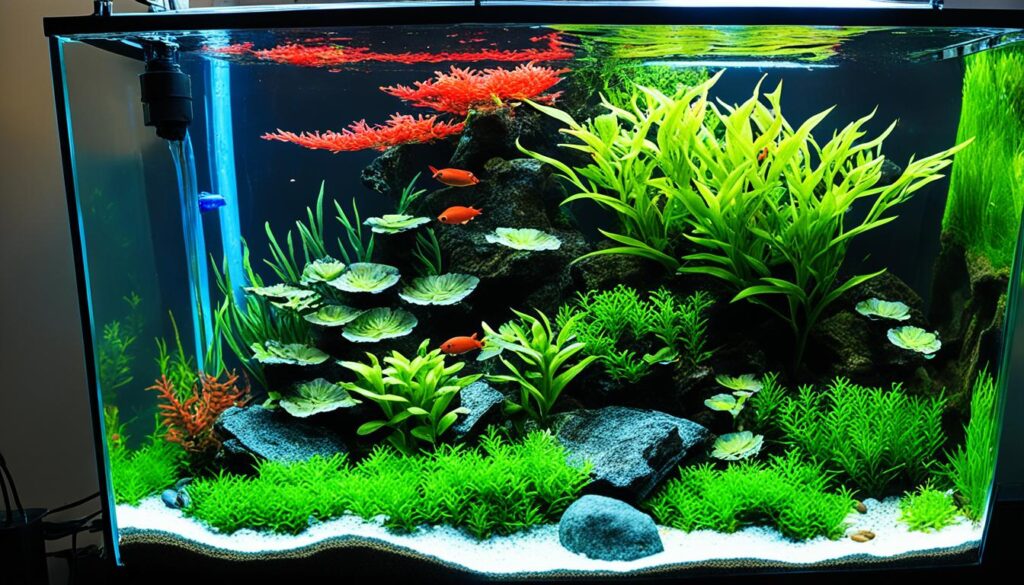
In the next section, I will discuss effective methods to cool down your aquarium’s temperature during heat waves.
Cooling Methods for Aquariums During Heat Waves
During hot weather seasons and heat waves, it is crucial to take measures to prevent aquarium water from becoming too hot. Overheating can negatively impact the health and well-being of your fish. Fortunately, there are various effective methods to cool down the temperature in your aquarium and create a comfortable environment for your aquatic pets.
1. Increase Aeration and Oxygenation
Poor water circulation and low oxygen levels can contribute to high temperatures in your aquarium. By increasing the aeration and oxygenation in the water, you can help cool it down. Consider adding additional air stones or increasing the flow rate of your aquarium filter to improve water movement and oxygen exchange.
2. Use a Cooling Fan
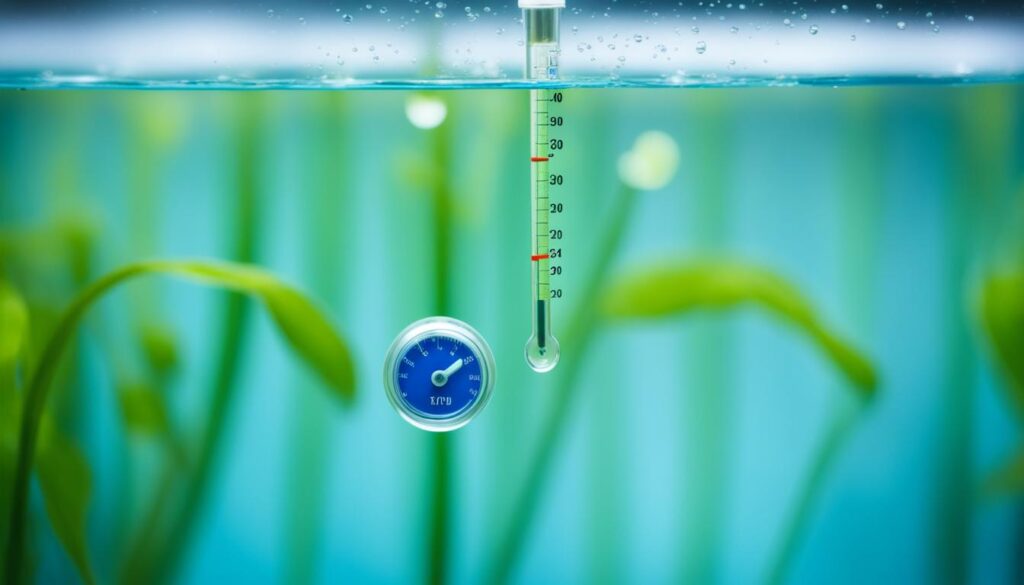
A cooling fan can be a simple and effective solution to lower the temperature in your aquarium during heat waves. Position the fan in a way that it blows across the surface of the water, enhancing evaporation and cooling. You can utilize a clip-on fan or a fan designed specifically for aquarium use.
3. Install a Chiller
If you live in an extremely hot climate or experience prolonged heat waves, investing in an aquarium chiller may be necessary. Chillers are designed to cool down the water and maintain a stable temperature in the aquarium. They work by circulating water through a cooling system, removing excess heat and ensuring optimal temperature regulation.
4. Add Frozen Water Bottles
A quick and cost-effective way to cool down aquarium water is by using frozen water bottles. Simply freeze a few clean, dechlorinated water bottles and place them in the aquarium. The cold water from the bottles will help lower the overall temperature of the tank. Monitor the temperature closely and adjust the number of frozen water bottles as needed.
5. Reduce Artificial Lighting
Excessive heat can be generated by aquarium lights, especially if they are powerful or emit a significant amount of heat. Consider reducing the duration or intensity of artificial lighting during heat waves to minimize heat buildup. This can help maintain a cooler temperature in the aquarium.
By implementing these cooling methods, you can effectively prevent overheating in your fish tank and ensure the well-being of your aquatic pets during hot weather conditions.
Preventing Temperature Changes in the Aquarium
When it comes to maintaining a stable temperature in your aquarium, preventing temperature fluctuations is key. Sudden changes in temperature can have adverse effects on your fish and other aquatic inhabitants. By taking steps to control heat transfer and minimize temperature swings, you can ensure a consistent and comfortable environment for your aquatic pets.
One effective method to prevent temperature changes is to insulate your aquarium. Insulating materials, such as foam or insulating sleeves, can help to regulate heat transfer between the water and the surrounding environment. This insulation creates a barrier that helps to maintain a steady temperature, preventing drastic fluctuations.
Another important factor to consider is the placement of your aquarium. Avoid placing it in areas with direct sunlight or near heat sources, such as radiators or vents. Direct sunlight and heat sources can significantly impact the temperature of the water, leading to unwanted fluctuations. Instead, choose a location that is away from direct sunlight and maintain a consistent room temperature.
In addition to insulation and strategic placement, it is also essential to have a reliable heating and cooling system in place. This system should include a thermometer and a temperature controller to accurately monitor and adjust the temperature as needed. Regularly check the temperature to ensure it remains within the desired range for your specific fish species.
By implementing these preventive measures, you can minimize temperature swings in your aquarium and create a stable and comfortable environment for your fish to thrive.
Comparison of Temperature Control Methods in Aquariums
| Method | Pros | Cons |
|---|---|---|
| Aquarium Insulation | – Effectively regulates heat transfer | – Requires additional setup – May impact aesthetics |
| Strategic Placement | – Helps to avoid direct sunlight and heat sources – Maintains stable room temperature |
– Limited placement options – May require rearranging furniture |
| Heating and Cooling System | – Provides accurate temperature monitoring and control – Enables precise adjustments |
– Requires initial investment – Requires maintenance and monitoring |
Implementing a combination of these methods can greatly contribute to preventing temperature fluctuations in your aquarium, ensuring a stable and comfortable environment for your aquatic pets.
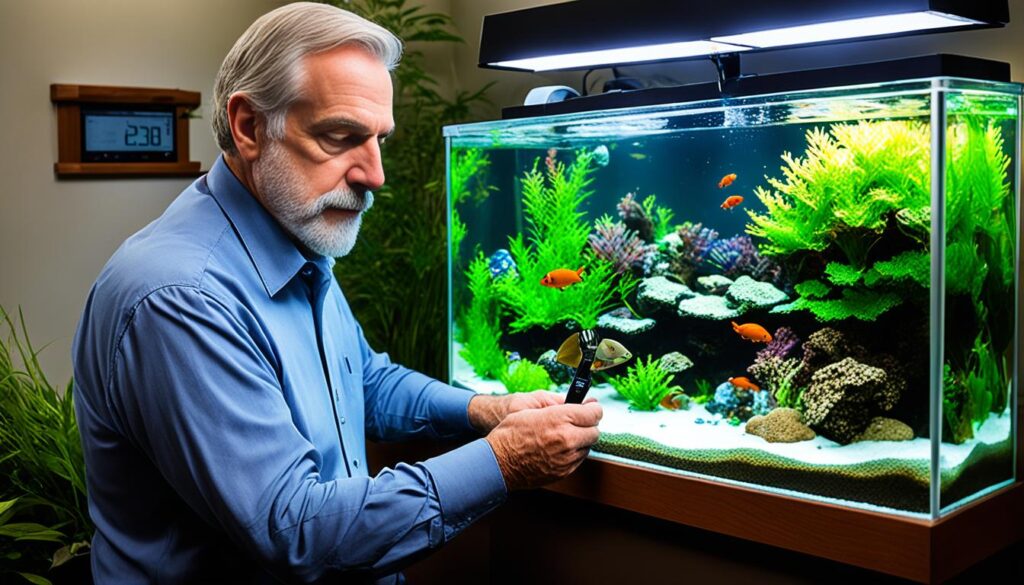
Monitoring and Adjusting Aquarium Temperature
As an aquarium enthusiast, I know the importance of maintaining the perfect temperature for the health and well-being of my fish. Regularly monitoring and adjusting the temperature in your aquarium is essential to create a safe and comfortable environment for your aquatic friends.
To effectively monitor the temperature, I highly recommend using thermometers specifically designed for aquarium use. These devices provide accurate readings and ensure that you have real-time information about the temperature in your tank. Place the thermometer in a central location, at the same level as your fish, for the most accurate results.
One of the popular options is the digital thermometer, which displays the temperature in a clear and easy-to-read format. These thermometers often come with adhesive backings, making it easy to attach them to the inside of your tank.

Temperature controllers are another valuable tool for maintaining the desired temperature range. These devices automatically adjust the temperature by turning the heater on or off, ensuring a consistent environment for your fish. They are especially useful if you have a busy schedule or are away from home for extended periods.
I also recommend keeping a log of your temperature readings. This will help you identify any fluctuations or patterns that may require adjustments. Note down the date, time, and temperature at each reading to track any changes over time.
Pro Tip: Adjusting the aquarium temperature should be done gradually. Sudden changes can stress your fish and compromise their health. Make gradual adjustments over the course of several days, and closely monitor your fish for any signs of distress.
Remember, different species of fish have different temperature preferences. Research the specific temperature requirements for your fish and ensure that their habitat matches their needs. By regularly monitoring and adjusting the temperature, you can create a comfortable and thriving environment for your aquatic companions.
Factors Affecting Aquarium Temperature
When it comes to maintaining the optimal temperature in your aquarium, it’s essential to understand the factors that can influence temperature fluctuations. These factors include room temperature, seasonal changes, and the equipment used in your aquarium setup.
1. Impact of Room Temperature on Fish Tank
The room temperature where your aquarium is located plays a significant role in determining the temperature of the water. The ambient room temperature can affect the aquarium temperature, especially if there is inadequate insulation or if the room experiences extreme heat or cold.
During colder months, room temperature changes can cause the aquarium water temperature to drop. On the other hand, during hot summer months, the room temperature may increase, leading to higher water temperatures in the aquarium.
It’s important to consider the room temperature and make necessary adjustments to maintain a stable environment for your fish.
2. Seasonal Temperature Changes in Aquariums
Seasonal changes can also have a direct impact on the temperature of your aquarium. As the external temperature fluctuates, it can influence the water temperature inside the tank.
During winter, the colder temperature can cause the water in the aquarium to cool down. On the other hand, during summer, the warmer weather can lead to an increase in the water temperature.
Understanding the seasonal temperature changes and preparing your aquarium for these fluctuations is essential for maintaining a healthy and comfortable environment for your fish.
3. Equipment and Its Effect on Aquarium Temperature
The equipment you use in your aquarium setup, such as heaters, filters, and lighting systems, can also impact the overall temperature in your aquarium.
For example, aquarium heaters are used to warm the water and maintain a stable temperature. However, if the heater malfunctions or is not properly calibrated, it can cause dramatic temperature changes, which can be harmful to your fish.
Similarly, powerful lights in the aquarium can generate heat and raise the water temperature. It’s crucial to choose appropriate lighting and ensure proper ventilation to prevent overheating.
Regularly monitoring the performance of your equipment and maintaining it properly is vital for controlling temperature fluctuations in your aquarium.
Managing Temperature: Tips and Best Practices
To manage and regulate the temperature in your aquarium effectively, consider the following tips:
- Keep the aquarium away from direct sunlight and drafty areas to minimize temperature fluctuations caused by room temperature changes.
- Use a reliable and accurate aquarium thermometer to monitor water temperature regularly.
- Invest in a high-quality aquarium heater and thermostat to maintain a stable and consistent temperature.
- Regularly clean and maintain your aquarium equipment to ensure proper functioning and prevent temperature irregularities.
Proper temperature management is crucial for creating a healthy and comfortable environment for your aquarium inhabitants. By understanding the factors that affect aquarium temperature and implementing best practices, you can provide the optimal conditions for your fish to thrive.
| Factor | Impact |
|---|---|
| Room Temperature | Influences the overall temperature of the aquarium water. |
| Seasonal Changes | Can cause fluctuations in the aquarium temperature due to external weather conditions. |
| Equipment | Improperly functioning or inadequately maintained equipment can lead to temperature irregularities. |
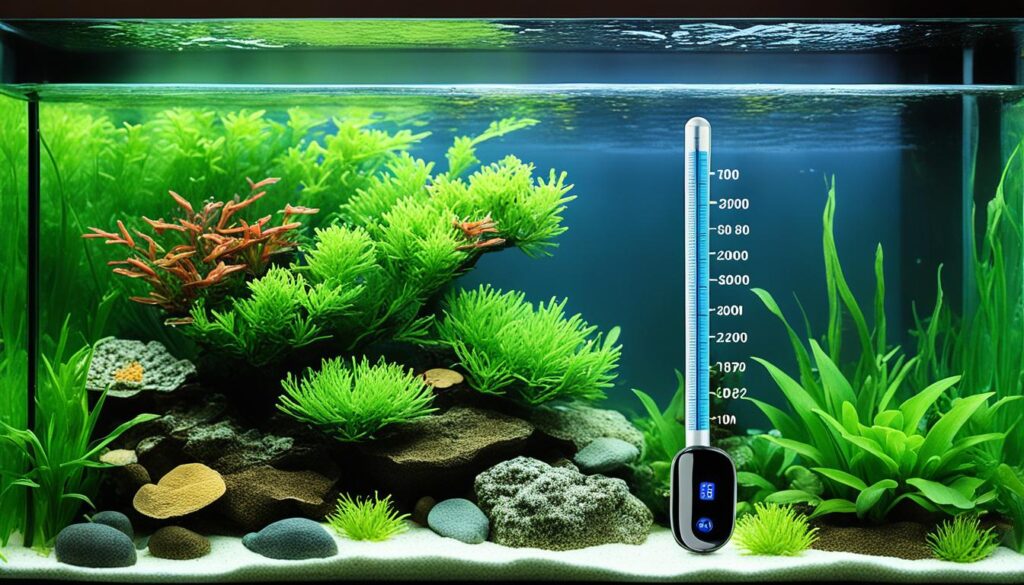
Conclusion
Proper temperature control is vital for maintaining a healthy and thriving freshwater aquarium. By following these essential tips, you can create a stable and comfortable environment for your fish to thrive. Remember to monitor and adjust the temperature regularly to ensure the well-being of your aquarium inhabitants.
To maintain the optimal temperature in your fish tank, start by choosing the right temperature range for the specific fish species in your aquarium. Research their temperature preferences and create a habitat that mimics their natural environment.
Invest in a reliable aquarium heater to regulate the water temperature effectively. Set it up correctly and regularly check its function to maintain a stable and consistent temperature. Additionally, during heat waves, employ cooling methods such as fans or ice packs to prevent the water from becoming too hot.
Finally, remember to prevent sudden temperature changes in your aquarium. Minimize heat transfer by insulating the surroundings of your aquarium, avoiding direct sunlight, and maintaining a consistent room temperature. By implementing these freshwater aquarium temperature control tips, you can create a healthy and comfortable habitat for your aquarium fish.
FAQ
What is the importance of maintaining the proper temperature in a freshwater aquarium?
Maintaining the proper temperature in a freshwater aquarium is crucial for the health and well-being of the fish. It affects their overall well-being, metabolism, immune system, and ability to thrive.
How do I choose the right temperature for my freshwater aquarium?
Different fish species have different temperature preferences. It is essential to research the ideal temperature range for the fish you have in your aquarium and choose a temperature that will best suit their needs.
How can I maintain a consistent water temperature in my aquarium?
Keeping the water temperature in your aquarium stable is crucial. Sudden temperature fluctuations can stress and even harm the fish. Learn how to maintain a consistent water temperature to ensure the well-being of your aquarium inhabitants.
What equipment do I need to control the temperature in my freshwater aquarium?
A heater is an essential tool for temperature control in a freshwater aquarium. Learn how to properly choose and set up a heater to effectively regulate the temperature in your aquarium.
How can I cool down the temperature in my aquarium during heat waves?
During hot weather seasons and heat waves, it may be necessary to employ cooling methods to prevent the aquarium water from becoming too hot. Explore different techniques to cool down the temperature in your aquarium during heat waves.
How can I prevent temperature changes in my aquarium?
To maintain a stable temperature in your aquarium, it is important to prevent temperature changes. Learn how to minimize heat transfer and ensure a consistent temperature in your fish tank.
What tools can I use to monitor and adjust the temperature in my aquarium?
Regularly monitoring and adjusting the temperature in your aquarium is essential for maintaining a healthy environment for your fish. Discover the tools and techniques to effectively monitor and adjust the temperature in your aquarium.
What factors can affect the temperature of my aquarium?
Several factors can affect the temperature of your aquarium, including room temperature, seasonal changes, and equipment used. Understand the different factors that can influence the temperature in your aquarium and how to manage them.
How important is it to control the temperature in a freshwater aquarium?
Proper temperature control is crucial for maintaining a healthy and thriving freshwater aquarium. By following these essential tips, you can create a stable and comfortable environment for your fish to thrive. Remember to monitor and adjust the temperature regularly to ensure the well-being of your aquarium inhabitants.
